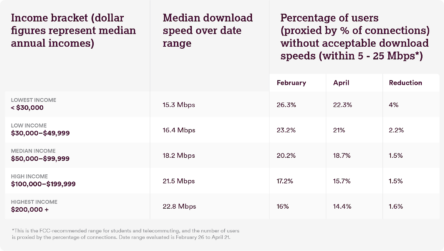Fastly, Inc. (NYSE: FSLY), a global edge cloud platform, today announced a February to April 2020 analysis of internet performance within median income brackets in the U.S. The first in a series of data analyses on the digital divide — the unequal distribution of internet access across socioeconomic and geographic lines — these findings uncover a clear stratification of download speeds, indicating households with lower incomes experienced lower download speeds compared to households with higher incomes. In the weeks since the onset of the COVID-19 pandemic, more and more people around the world are relying on the web for work and education from home, bringing the internet’s inequities into sharper focus. A beacon of hope lies in recent internet service provider (ISP) decisions to upgrade internet speeds for lower income communities, which analysis shows has led to noticeable improvements in internet performance. Notably, Fastly’s data only represents those who have some sort of residential internet connection, and does not include a group at the very heart of the digital divide issue — those without internet at all.
“We hypothesized that internet performance would vary by income, but we were surprised to see such a stark stratification,” said Fastly’s Chief Architect and Founder, Artur Bergman. “Because of Fastly’s visibility into telecommunications and ISP activity, as well as end user experience, we can connect threads that help to define the tangibility of the digital divide for many communities in the U.S. This becomes especially insightful as more and more people transition to a more web-reliant world in light of COVID-19. We observed relief for those segments of the population arise as a result of decisions from ISPs like Comcast and Cox Communications. Both implemented upgraded internet speeds in mid-March, which led to recognizable improvements in download speed for lower-income communities.”
As Web-Reliance Increases, Low Income Communities Could Struggle With Connectivity
To understand the impact of the digital divide on low-income families during the COVID-19 pandemic, Fastly compared the median download speed between February 26 and April 21 for five brackets of annual average income. Download speed is a measure of the bandwidth that a user’s connection to our server achieves, which is typically lower than the connection speed users signed up for with their internet providers. The analysis shows ZIP Codes with median incomes in the highest brackets are seeing the highest download speeds, compared to ZIP Codes with the lowest median incomes, which are seeing the lowest download speeds. This reflects that, among other inequities, people in higher income neighborhoods have both access to higher bandwidth connectivity and the means to use it.










